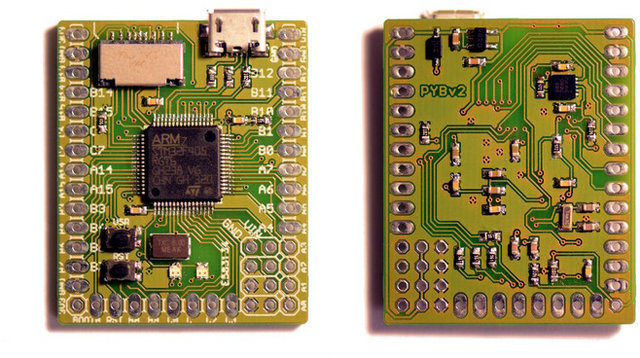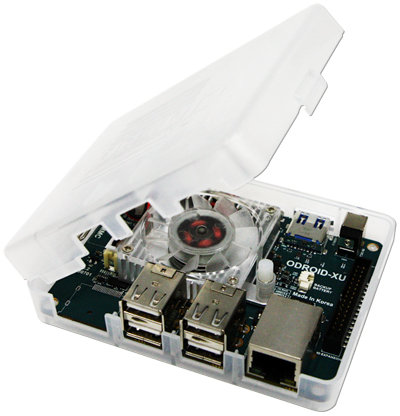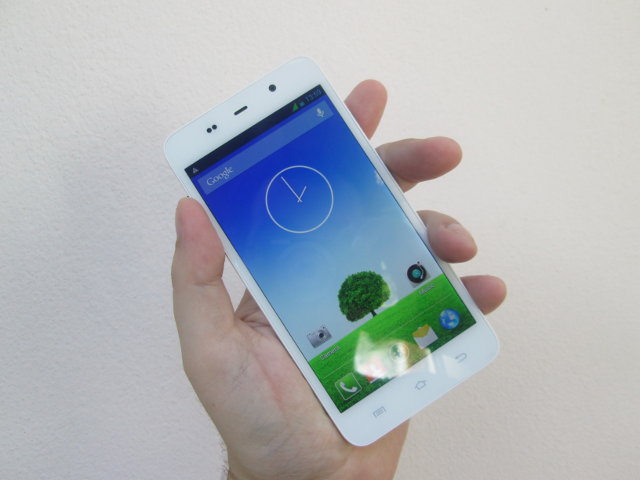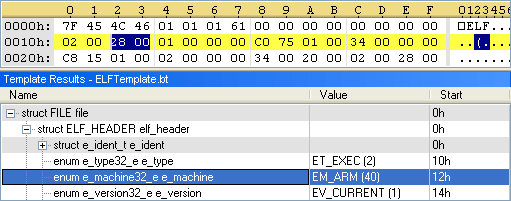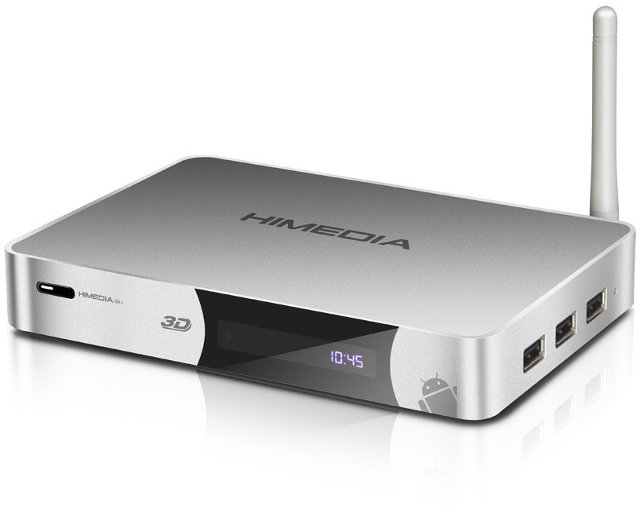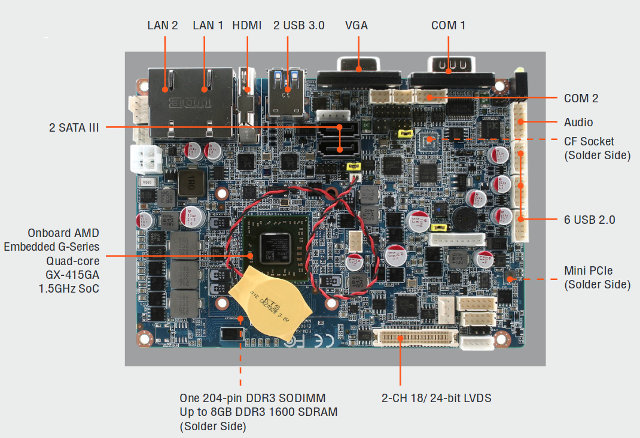Micro Python is an implementation of the Python programming language, written from scratch and optimized to run on micro-controllers such as the ones based on ARM Cortex-M cores. Damien George, the developer, also designed the Micro Python board powered by STMicro STM32F405 Cortex M4 MCU for the purpose of running Micro Python. Even though in this project, the star of the show is not the board itself, as Micro Python will run on other platform once it’s open source, let’s have a look at the hardware specifications: MCU – STMicro STM32F405RG @ 168MHz with 1MB flash, 192KB RAM, and an FPU. External storage – Micro SD slot 30 general purpose I/O pins – 5 USARTs, 2SPIs, 2 I2C busses, 14 ADC pins, 2 DAC pins, 2CANs, and 4 servo ports with power. Built-in USB interface Misc – 4 LEDs, a user switch, a reset switch, a real-time clock, and a 3-axis […]
Hardkernel ODROID-XU Lite Development Board Features Exynos 5410 @ 1.4GHz for $139
Hardkernel ODROID-XU development board launched for $149, and now costs $169. Hardkernel has recently announced a cost-down version named ODROID-XU Lite, with almost exactly the same specifications: Samsung Exynos 5410 Octa Core big LITTLE Cortex A15/A7 processor, 2GB RAM, eMMC storage, etc.. The only differences are that the Cortex A15 cores are clocked up to 1.4GHz instead of 1.6GHz, and you’ll save $30, as the Lite version costs $139. Here’s a reminder of the specifications: SoC – Samsung Exynos5 Octa Cortex-A15 @ 1.4GHz and Cortex-A7 big.LITTLE processor with PowerVR SGX544MP3 GPU System Memory – 2GB LPDDR3 RAM Storage – micro SD slot, eMMC 4.5 connector Video Output – micro HDMI + MPI LCD interface and Touch screen I2C ports (IPEX-40PIN) Audio – micro HDMI, headphone jack, MAX98090 Audio Codec Connectivity – 10/100M Ethernet via USB 2.0 (LAN9730) USB – 1x USB 3.0 Host, 1x USB 3.0 OTG, and 4x USB […]
ThL W200 Smartphone Review (Mediatek MT6589T)
I’ve received ThL W200, a smartphone powered by Mediatek MT6589T SoC, at the beginning of week (Check specs and unboxing pictures), and after about a week of use, it’s time for a review. First I’ll go through my first impressions, test of different features such as the camera, GPS, and Bluetooth, and finally run some apps to get system information and benchmarks for this phone. ThL W200 Review This smartphone feels very light, but the build quality is good, and as explained in my unboxing post, comes with power, volume -/+, and menu/home/back buttons. You’ll also find rear camera + flash, front camera, the light sensor, and the notification light. First impressions The phone boots to the standard Android home screen, as shown above, with English as the default language, and comes with Google Play Store, and no Chinese apps. The 720p screen provide a sharp and clear display, and […]
XBMC MX Linux v1.00 RC1 for AMLogic AML8726-MX Devices
Developer “croniccorey” has recently announced the release of MX Linux v1.00 RC1, an XBMC Linux image for media players based on AMLogic AML8726-MX, on XDA Developers’ Forums. This release supports G18REF and MX2REF devices (See build.prop in Android) such as Matricom G-Box Midnight MX2, and a test image has also been released for g02refDongle devices such as Droid Stick A2. Checking the MTD layout Before starting the installation, you may want to check your flash partitions in order to avoid bricking your device: Install and run Terminal Emulator Run the command below to make sure your partition table is compatible with the image:
|
1 2 3 4 5 6 7 8 9 10 11 |
[root@amlogic /]# cat /proc/mtd dev: size erasesize name mtd0: 00400000 00200000 "ubootenv" or "bootloader" mtd1: 00800000 00200000 "logo" mtd2: 00800000 00200000 "aml_logo" mtd3: 00800000 00200000 "recovery" mtd4: 00800000 00200000 "boot" mtd5: 40400000 00200000 "system" mtd6: 20000000 00200000 "cache" mtd7: 10000000 00200000 "backup" mtd8: 18c800000 00200000 "userdata" |
If your partition table is different, do not install the default image for MX2REF / G18REF. However, If you’ve got Matricom Android firmware version 1.1.6 or greater or WJB’s Linux builds from November 21 2013 onwards, the MTD layout will be different, and you’ll need to […]
Linux.Darlloz Worm Targets Embedded Linux Devices
Symantec has recently discovered a new Linux worm, called Linux.Darlloz, that targets Internet-enabled devices running Linux in addition to traditional computers. That means devices such as home routers, set-top boxes and security cameras could be at risk of infection, although no attacks against non-PC devices have been confirmed yet. The worm exploits an “old” PHP vulnerability, which was patched in May 2012 (PHP 5.4.3, and PHP 5.3.13), and currently only affects Intel (x86) based systems. So you’d need an embedded system powered by an Intel processor, running Linux and PHP to be at risk. Having said that, Symantec also explains code for other architectures such as ARM, PPC, and MIPS, is also present in the worm, and these systems could potentially be at risk too with small modifications. Here’s how the worm operates: Upon execution, the worm generates IP addresses randomly, accesses a specific path on the machine with well-known […]
Linaro 13.11 Release with Linux Kernel 3.12 and Android 4.4
This release includes Linux Kernel 3.12 (baseline), Linux Kernel 3.10.20 (LSK), Android 4.4 for the first time, and Ubuntu Linaro 13.11 (still based on Raring). Beside Android Kit Kat support, other noticeable updates include initial documentation for LAVA, and further work on ARMv8 support. Here are the highlights of this release: Android Engineering Android 64-/32-bit updated to 4.4 KitKat Fastboot/UEFI – Created Fastboot app design Builds and Baselines Linaro Stable Kernel 3.10.20-2013.11 released – Includes an updated big.LITTLE MP patchset Linux Linaro 3.12-2013.11 released: gator version 5.16 (same version as in 13.10 release) updated big-LITTLE-pmu, iks, iks-cpufreq, and interactive-gov-updates topics from ARM LT updated basic Capri board support from Broadcom LT (generic phy support for USB, watchdog, updated bcm_defconfig) updated big endian topic updated topic to support K3V2 board from Hisilicon LT updated Versatile Express patches from ARM LT vexpress64 support (updated FVP Base model files, added support for FVP […]
HiMedia Q5II Android STB Features HiSilicon Dual Core SoC, a 2.5″ SATA HDD Bay, and Supports XBMC Hardware Decode
Many Android set-top boxes are based on application processors mainly targetting tablets such as Rockchip RK3188, and media capabilities including video quality, and audio pass-through are not always optimal, or not working at all. On the contrary, HiMedia Q5II, an Android 4.2 media player, is powered by HiSilicon 3718 (or is it Hislicon 3716C V200?), a dual core Cortex A9 SoC designed specifically for media players. It also features an external SATA slot, HDMI and composite video output, optical and coaxial S/PDIF, and I’ve just found out the company worked on making video hardware decoding work with XBMC. HiMedia Q5II specifications: SoC – HiSilicon Hi3716C V200 dual core ARM Cortex A9 @ 1.6GHz + ARM Mali-400MP4 GPU. N.B.: HiMedia indicates the processor is Hi3718, but most resellers give specifications with a dual core processor called 3716C… Hi3718 is not listed at all in HiSilicon website, and Hi3716C is a single […]
Avalue ECM-KA SBC Powered by AMD Embedded G-Series Dual and Quad Core SoCs
Avalue Technology, a Taiwanese company manufacturing industrial and embedded single board computer, has recently announced a 3.5” SBC (single board computer) micro module, labeled ECM-KA, powered by AMD Embedded G-Series SoCs. The board will feature GX-415GA Quad-core SoC by default, with GX-217GA (1.6GHz), and GX-210HA (1.0GHz) dual core SoCs as options. The board targets the embedded market with applications such as industrial controls & automation, gaming (e.g. slot machine, aracade), thin clients, retail/ digital signage, SMB storage server, surveillance, medical, communication, entertainment, and data acquisition. ECM-KA Specifications: SoC – AMD Embedded G-Series Quad-core GX-415GA @ 1.5GHz SoC with on-chip Radeon HD 8400E GPU (Optional GX-217GA 1.6GHz/ GX-210HA 1.0GHz) System Memory – One 204-pin DDR3 SODIMM Socket Supports Up to 8GB DDR3 1600 SDRAM Storage – 2x SATA III and SSD One CompactFlash Type I/II Socket (Support InnoDisk CF-SATA). Expansion – 1x Mini PCIe (mSATA Supported) I/O MIO – 1 x […]


